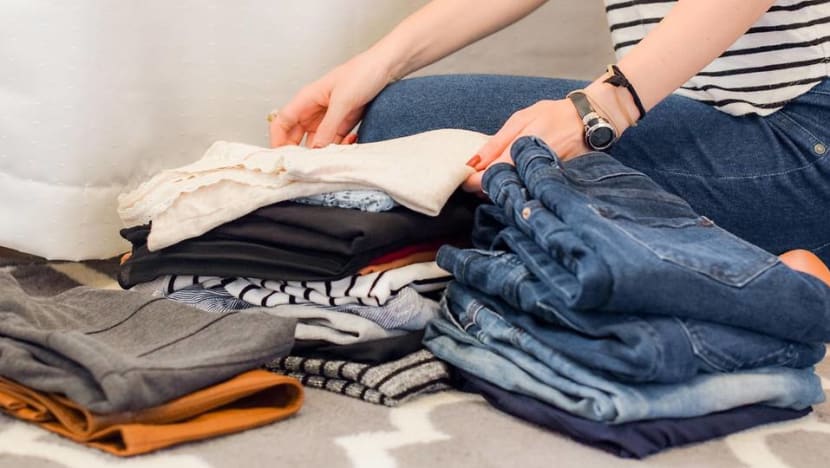commentary Commentary
Commentary: S$5 tank tops can end up costing too much
Too often, the companies who make these clothes cheap don’t make them well, says Tammy Gan.

File photo of a clothing shop's storefront.
SINGAPORE: I can’t remember the last time I walked into a brick-and-mortar fast fashion retail store.
And no, it’s not because the pandemic has made me wary of unnecessary contact with people. Neither is it because I’ve picked up an online shopping habit instead.
It’s because I’ve more or less given up on fast fashion.
I used to love it. I spent my early teenage years shopping regularly at H&M, noticing that every other week, when I returned, the entire store’s inventory had changed, like magic.
I remember going up and down the escalators at Somerset 313’s Forever 21 with friends, spending time in the changing rooms of Cotton On, trying on outfits and snapping selfies in them.
But I also remember the flimsy quality of those S$15 rompers, the sheer, see-through design of the S$5.99 tank tops, and the many times S$14.99 sandal straps broke … in public.
READ: Commentary: Shorts and slippers aren’t sloppy – they’re sensible attire for Singapore’s weather
READ: Commentary: I tried shopping for new clothes for Chinese New Year. It went abysmally
Today, my closet is made up of more reliable items of clothing: Wearable, repeatable pieces from secondhand fashion accounts on Carousell or friends’ closets, mixed in with fun and colourful vintage numbers from thrift shops, and the occasional splurge on ethical fashion pieces.
I’m not saying a higher price tag equates to better quality. And I still own pieces of fast fashion that have lasted – I frequently reach for my thrifted pair of Zara pants, and my Cotton On mock neck top remains a wardrobe staple, even after many years of wear.

But we still should be curious about the true cost of fast fashion.
THE TRUE COST OF FASHION
Too often, the companies who make these clothes cheap don’t make them well. The entire business model of fast fashion companies is built upon our ultra-fast consumption of clothing: The more we buy, the more they make. Which means the faster we dispose of our clothing, the better (for them).
So that frustration you feel when a cheap piece of clothing falls apart, and the sigh and shrug that accompanies you going into the store to replace it? It’s entirely intended and works in their favour.
READ: The true cost of demand for cheap clothes, to you and the environment
Fast fashion grows its empire by making consumers feel like they need to keep buying more, which explains the constant emails, endless sales and relentless collection drops.
These days, fast fashion brands go by “micro-seasons”, producing much more than how they used to produce – that is, according to the actual seasons. Hence, total clothing production has roughly doubled since 2000.
Such clothing may be affordable, but what is the price we really pay?
READ: Commentary: Following a T-shirt from cotton field to landfill shows the true cost of fast fashion
Much has been written about the environmental cost of these cheap clothes, from cradle to grave. The fashion industry uses 79 trillion litres of water every year to produce cotton and other textiles, and produces 92 million tonnes of waste a year.
It’s responsible for 10 per cent of global carbon emissions – more than that of flights and maritime shipping combined.
And it’s not just destroying the planet. News report after news report detail examples of how the fashion industry is rife with exploitative practices and human rights abuses. Hidden behind layers of sub-contracting are gruelling working hours, low pay, lack of job security, dangerous (and fatal) working conditions and suppression of trade unions.
READ: Can fast-fashion’s US$2.5 trillion supply chain be stitched back together?
OUR CLOTHES HAVE STORIES
But what happens to us when we purchase disposable fashion? The inconvenience of it all is one thing, but buy-and-throw-away culture has undeniably changed the way we engage with our clothing.

As we purchase more and more clothes, these items become utilitarian – we buy them solely to complete our outfits, chase after trends and feel the rush of owning something new.
But clothes can have stories, and we can have relationships with the clothes we own.
Earlier this year, I was invited to a private, pandemic-safe clothes swap by a friend. There were six of us, and each of us brought items that we had loved, but were ready to part with.
The swap started with us going through each of our items in a show-and-tell format. We recounted where we bought them, the places they had been with us, the points of our lives during which they were featured the most.
WATCH: Swop, don't shop: Upcycling and recycling in preparation for Chinese New Year | Video
That day, after giving away a number of mine, I adopted a pair of black polyester pajama pants with Chinese characters printed on them, an oversized pink and brown loose-knit blouse, a pair of dark denim Armani jeans and a Boy Scouts of America uniform shirt.
Each of them, I imagined, had their own stories beyond the stories that were told that day. But more than the acquisition of those pieces themselves, I felt like I’d taken pieces of those who owned them.
It hit me then that I couldn’t recall the last time I felt connected to the items of clothing I owned. I had a wardrobe full of stuff, but the stuff had no meaning beyond their utilitarian function.
READ: Commentary: Five pandemic lessons we have learnt that should tide us over any surge in cases
RETHINK, SLOW DOWN AND ASK QUESTIONS
Rather than Marie Kondo our clothes away and down-size our wardrobes, perhaps the solution to regaining that attachment to our clothes is to rethink how we consume them, and then slow down.
To start, we can get more intentional about our purchases.

This doesn’t mean we have to buy more expensive, ethical fashion. I’ve found thrifting to be much more of a thrilling experience than regular shopping.
Thrifting runs the gamut of charity shops, secondhand shops tucked away in quiet malls or unsuspecting buildings and even pop-up events. Check out New2U (a classic), The Fashion Pulpit (for more comfortable try-ons) or Five Finds Thrift Market (packed with Gen-Z styles).
There are hidden gems everywhere, you never know what you’ll find, and you’ll never look the same as someone else.
Organising a clothes swap among your friends or community also achieves the same effect, and is not as logistically complex as you might think.
READ: Commentary: Secondhand clothing sales are booming – and could be the answer to fashion’s sustainability crisis
READ: Commentary: Missing the thrill of dressing up for work as a man
Practicing better care for the clothes we currently own is a way to start too. If not picking up repairing skills yourself (ever heard of visible mending or upcycling?), try visiting the many tailoring shops we have on the island and supporting a dying trade, instead of just buying something new.
Individual consumers not consuming fast fashion alone is not going to be sufficient. Unplugging the fast fashion machine requires shedding light on the unethical practices of fast fashion companies, working with governments and international bodies to enact legislation to protect garment workers and our environment, which fashion activists are doing.
But activists need our help too: To set higher standards for our personal wardrobes (if we can), and beyond that, to ask more questions. To be more curious about what’s behind the label.
We don’t have to feel guilty that we can’t control the decisions made by fast fashion companies – but we can pressure them to make better, and make less.
If individual actions won’t move the needle on climate change, what will? Find out what climate activists are pushing for on The Climate Conversations:
Tammy Gan is a social media activist and freelance writer focused on getting people to think deeper about environmental and social justice issues, in service of more just futures.















